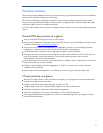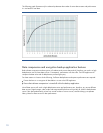
8
Appended backups need to “clone” the cartridge on the target side, so performance of appended tape
replication will not be significantly faster than replicating the whole cartridge.
If a lot of similar data exists on remote office D2D libraries, replicating these into a single target library will
give a better deduplication ratio on the target D2D Backup System.
Replication starts when the cartridge is unloaded or a NAS share file is closed after writing is complete, or
when a replication window is enabled. If a backup spans multiple cartridges or NAS files, replication will start
on the first cartridge/NAS file as soon as the job spans to the second.
Size the WAN link appropriately to allow for replication and normal business traffic taking into account data
change rates.
Apply replication bandwidth limits or apply blackout windows to prevent bandwidth hogging.
The maximum number of concurrent replication jobs supported by source and target D2D appliances can be
varied in the Web Management Interface to manage throughput. The table below shows the default settings for
each product.
Model
Fan in
Maximum number concurrent
source jobs
Maximum number concurrent
target jobs
D2D4324
50
16
48
D2D4312
50
16
48
D2D4112 G2
24
8
24
D2D4106i G2
16
8
24
D2D4106fc G2
16
8
24
D2D2504i G2
8
4
8
D2D2502i G2
4
4
8
D2D4112 G1
24
2
8
D2D4009i/fc G1
16
2
6
D2D4004i/fc G1
16
2
6
D2D2504i G1
8
2
3
D2D2503i G1
6
1
2
D2D2502i G2
4
2
3
Note: Fan in is the maximum number of source appliances that may replicate to the device as a replication
target.
Housekeeping overview
If data is deleted from the D2D system (e.g. a virtual cartridge is overwritten or erased), any unique chunks will
be marked for removal, any non-unique chunks are de-referenced and their reference count decremented. The
process of removing chunks of data is not an inline operation because this would significantly impact
performance. This process, termed “housekeeping”, runs on the appliance as a background operation, it runs on
a per cartridge and NAS file basis and will run as soon as the cartridge is unloaded and returned to its storage
slot or a NAS file has completed writing and has been closed by the appliance.
Whilst the housekeeping process can run as soon as a virtual cartridge is returned to its slot, this could cause a
high level of disk access and processing overhead, which would affect other operations such as further backups,
restores, tape offload jobs or replication. In order to avoid this problem the housekeeping process will check for
available resources before running and, if other operations are in progress, the housekeeping will dynamically


















